Orange Marmalade recipe made with beautiful Seville oranges for that bitter sweetness we all know and love. With my step-by-step photo guide and lots of tips on how to make it, you will be able to enjoy it on toast before you know it!
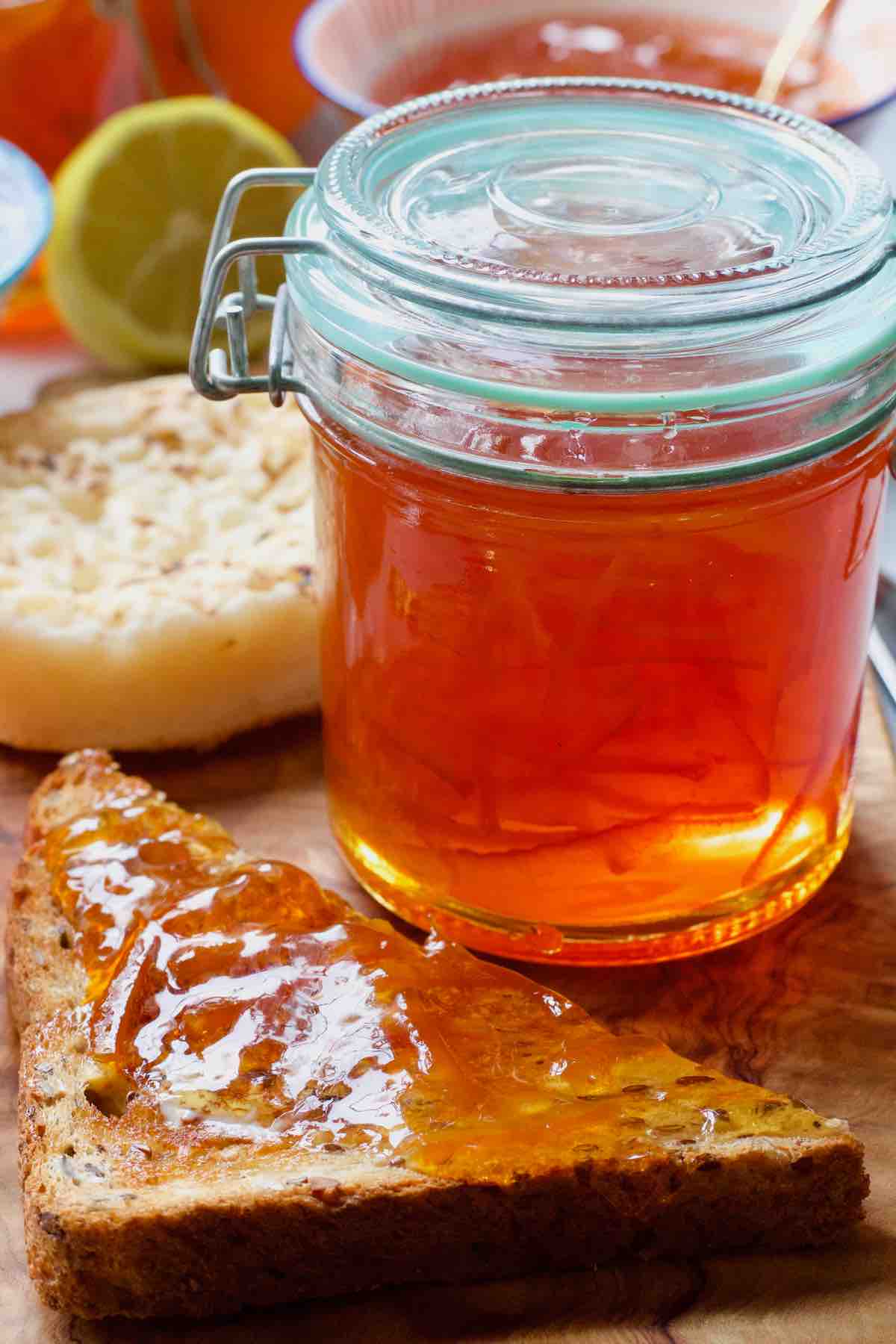
Orange marmalade is one of my favourite preserves ever. I absolutely adore its bittersweet flavour so beautifully delivered by Seville oranges.
Of course you can make it with other types of oranges but to me it's that bitterness that only Seville oranges can provide what marmalade is all about!
Marmalade making process, although not difficult, definitely requires some of your time. But there is no better way to spend one Saturday in January and immerse yourself in it. It's quite therapeutic really.
With the help of step-by-step photo guide and my tips and tricks on how to successfully make marmalade, you might even make it your annual tradition.
Jump to:
✔️ Why you'll love this recipe
- Easy to follow step-by-step instructions.
- All you need is 3 ingredients.
- Delicious homemade preserve.
- It makes a lovely gift for family and friends.
- Delicious spread on toast at breakfast.
- Can be used in baking as well as savoury dishes.
- It's naturally vegan and gluten-free.
📝 Ingredients
Here's what you will need to make my Seville Orange Marmalade:
Seville Oranges - They're bitter oranges that are really high in pectin and used mainly for making marmalade.
Their season is very short (end of December- mid February) but they freeze well so you can always freeze them to make marmalade when you've got time.
As we are using the entire fruit, I would highly recommend buying organic which keeps their skins free from pesticides.
You can make marmalade using sweet oranges instead, however as they're lower in natural pectin, you will get a softer set or might need to increase the amount of lemon juice.
Lemon Juice - We use it here for that extra bit of help with setting marmalade.
Sugar - Use either granulated, caster or preserving sugar (don't confuse it with jam sugar that contains added pectin). Don't use jam sugar for making marmalade as there is enough natural pectin in the fruit.
Caster sugar tends to dissolve quicker whereas preserving sugar which has larger crystals that dissolve more slowly and reduces the amount of impurities on the surface. Granulated sugar lies somewhere in between.
Water
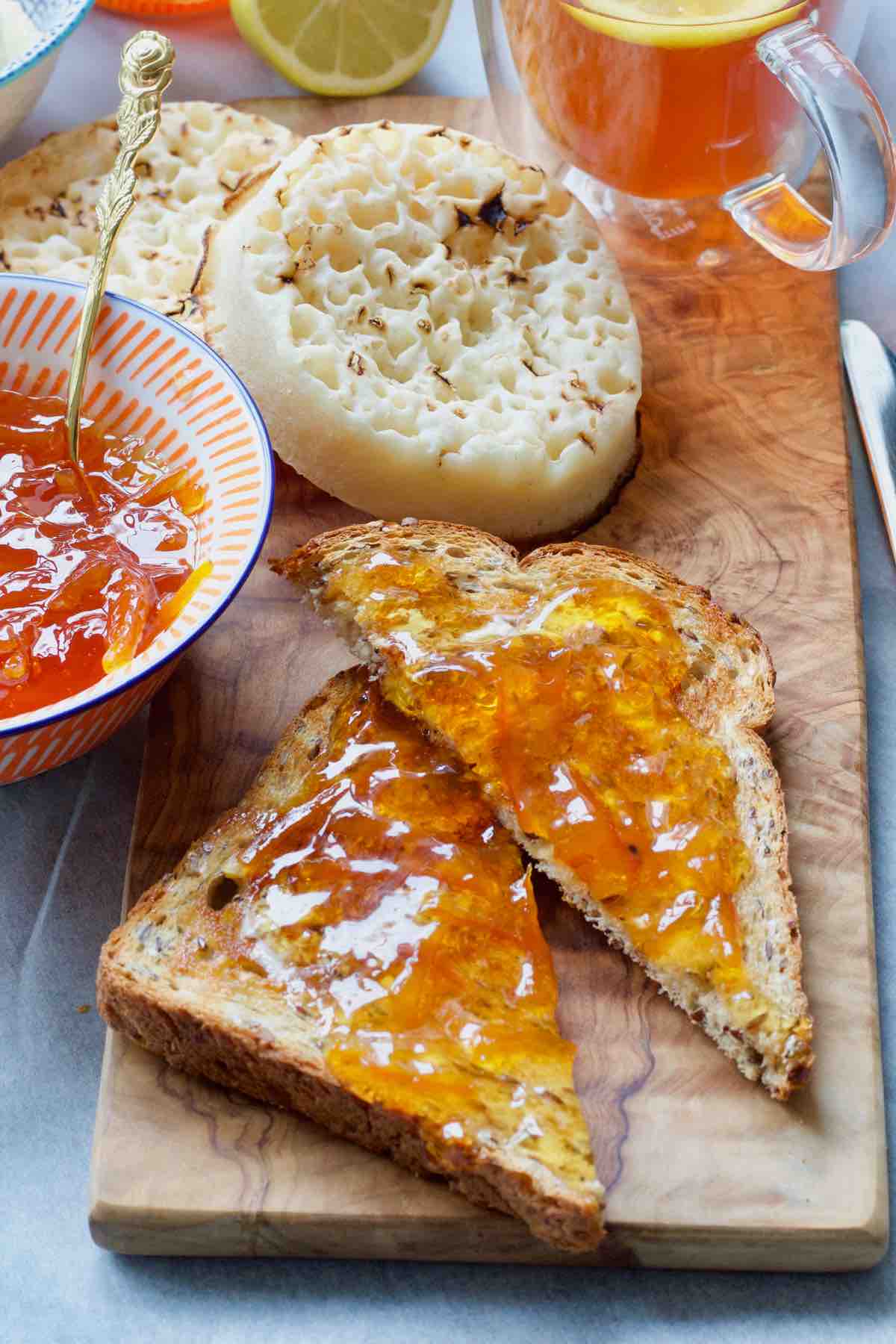
🔪 How to make marmalade
Ingredient quantities & detailed instructions to be found in recipe card at the bottom of the post.
Put 3-4 small saucers/plates in the freezer for later. You will need them to check whether marmalade has reached the setting point later.
Prepare the jars and make sure you've got the lids for all of them to avoid lots of faff later.
Cut oranges in half and squeeze out all the juice pouring it into the pan through the sieve to catch the pips. Remember to keep the pips!
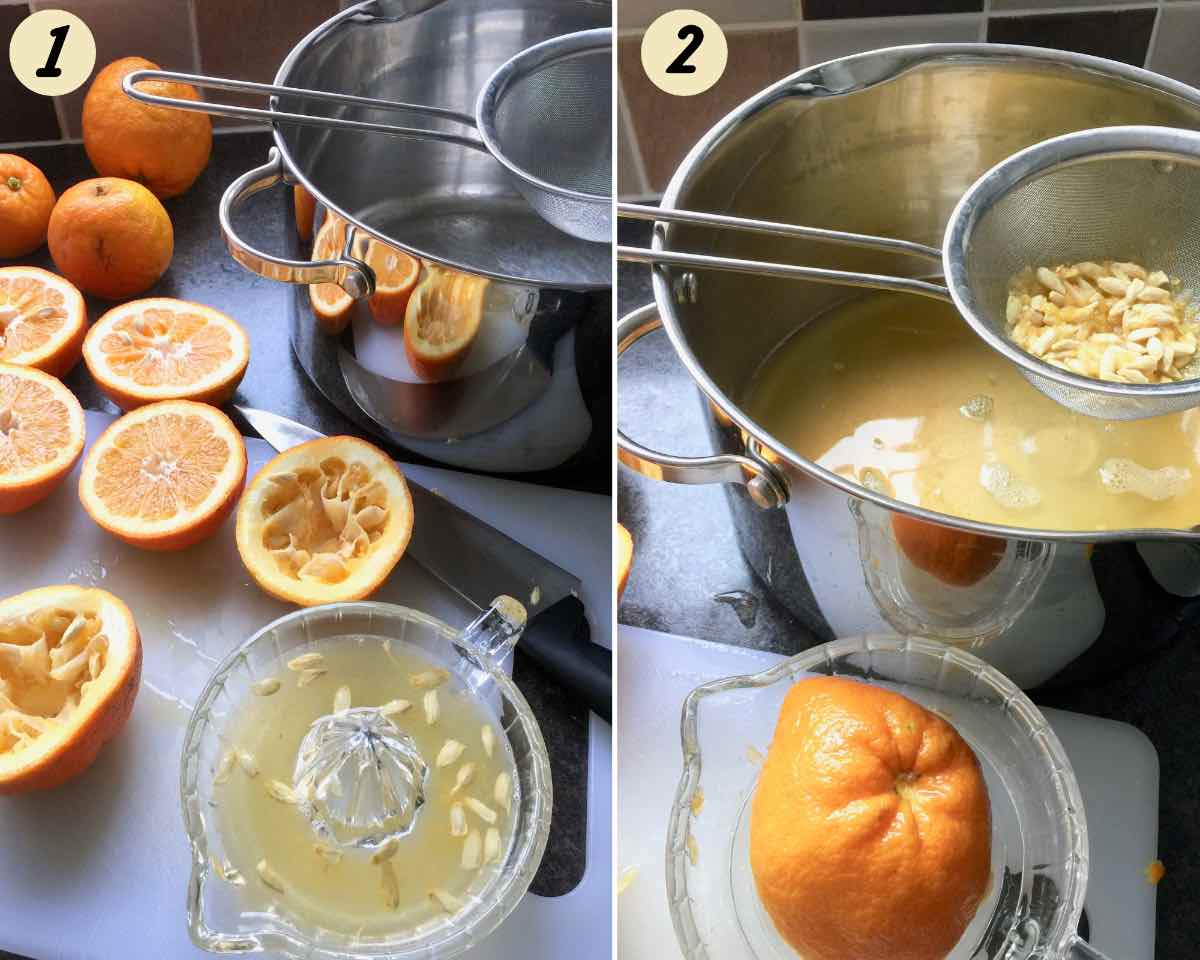
Cut the orange peels into quarters and using a teaspoon (find one with relatively sharp edge) scrape out as much of the white pith from the skins as possible. Put it aside with saved orange pips.

Take a muslin square/cotton cloth/cheese cloth and put all the pips and pith on it, gathering into a parcel and tying it up with a string or a strong thread.
Quick Tip: Make the string/thread long enough to be able to tie the parcel to the handle of the pot for easier removal later.
Put the bag into the pot and tie it onto the handle for easier removal later.
Do not skip this step as this pip/pith bag contains a lot of pectin you will need for your marmalade to set.
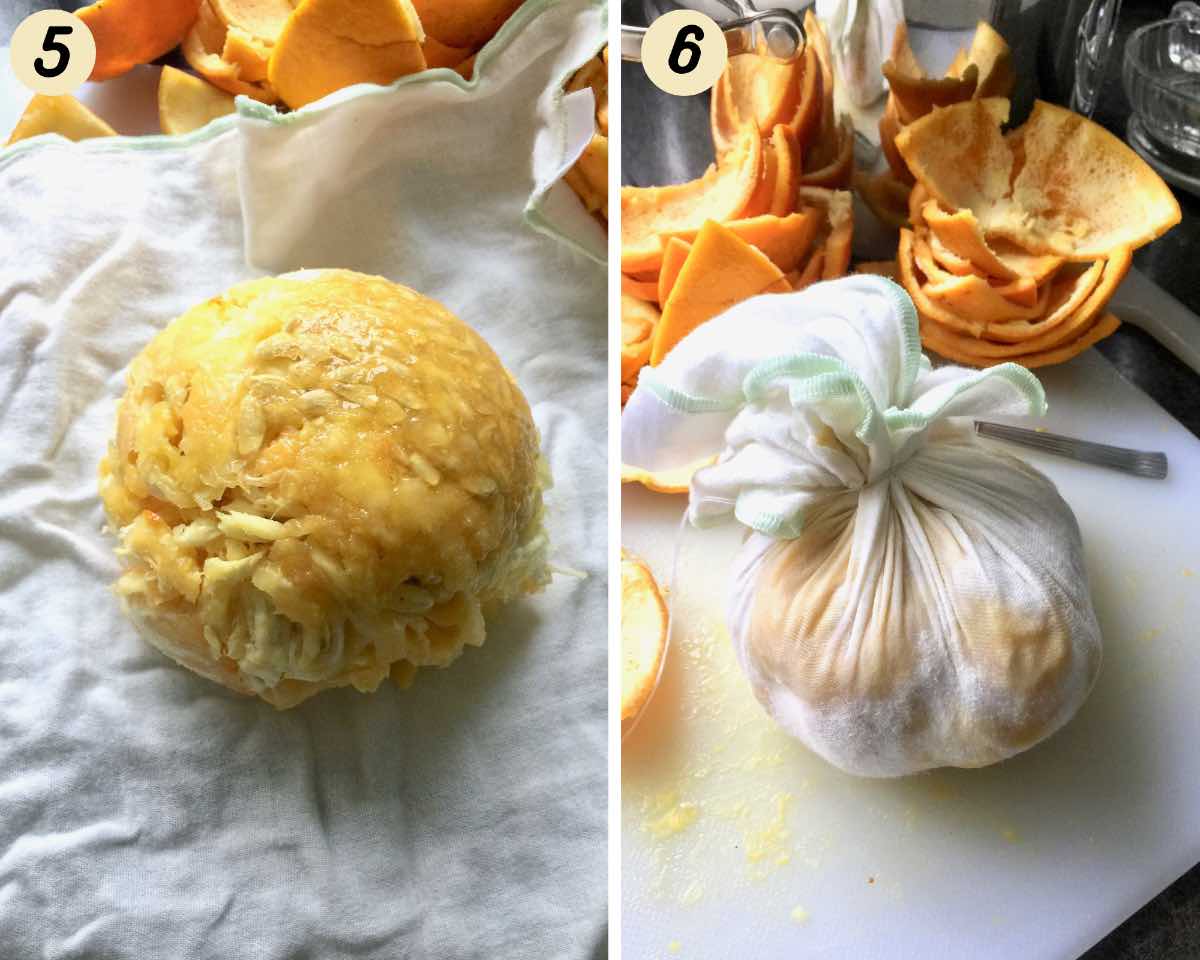
Cut orange peel into strips.
I like to cut my quarters into halves and slice them really thinly using a sharp knife. Feel free to cut your peel as thin or as thick as you like, it really is personal preference.
Once you’ve sliced all the peel pop it into the pan.
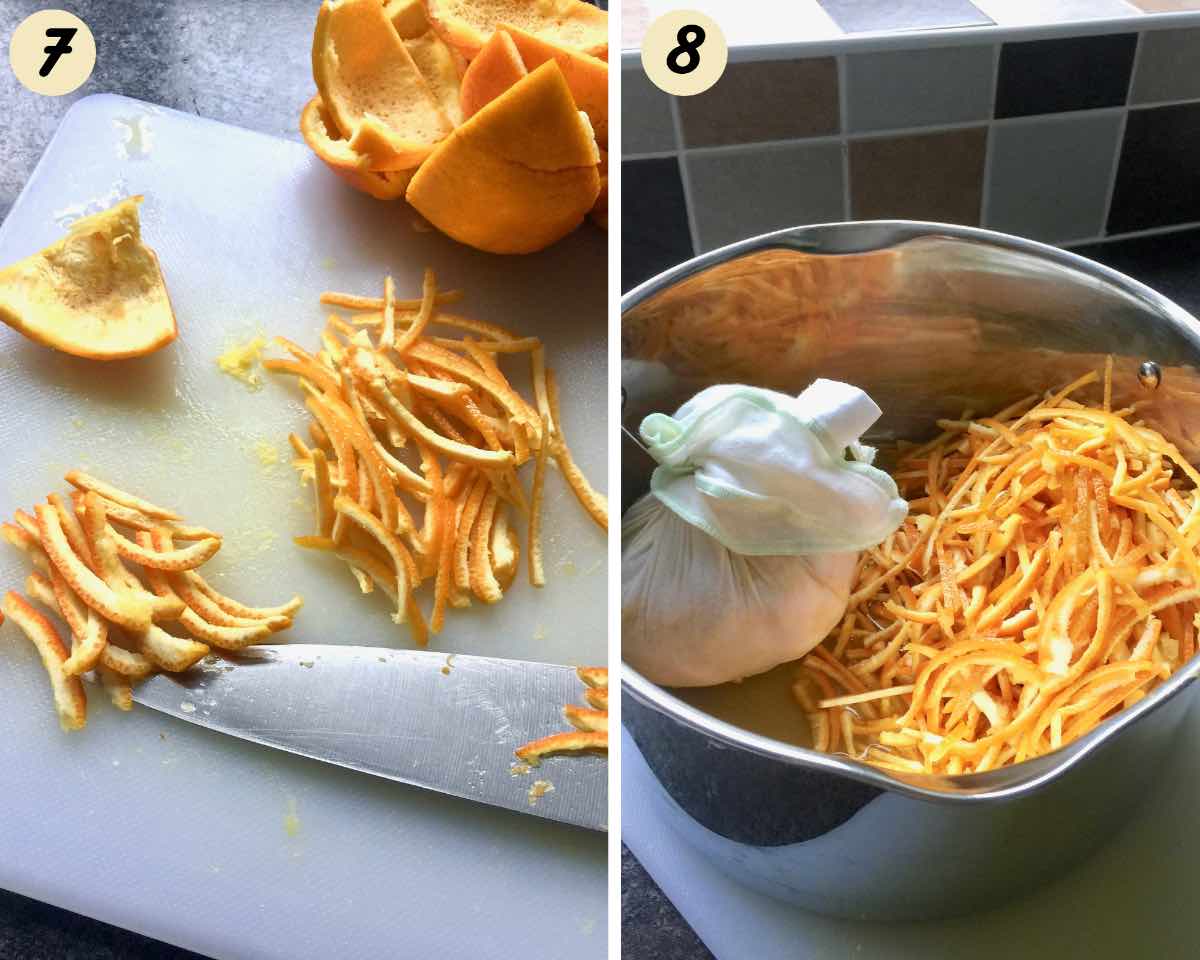
Halve and juice one lemon adding the juice to the pan.
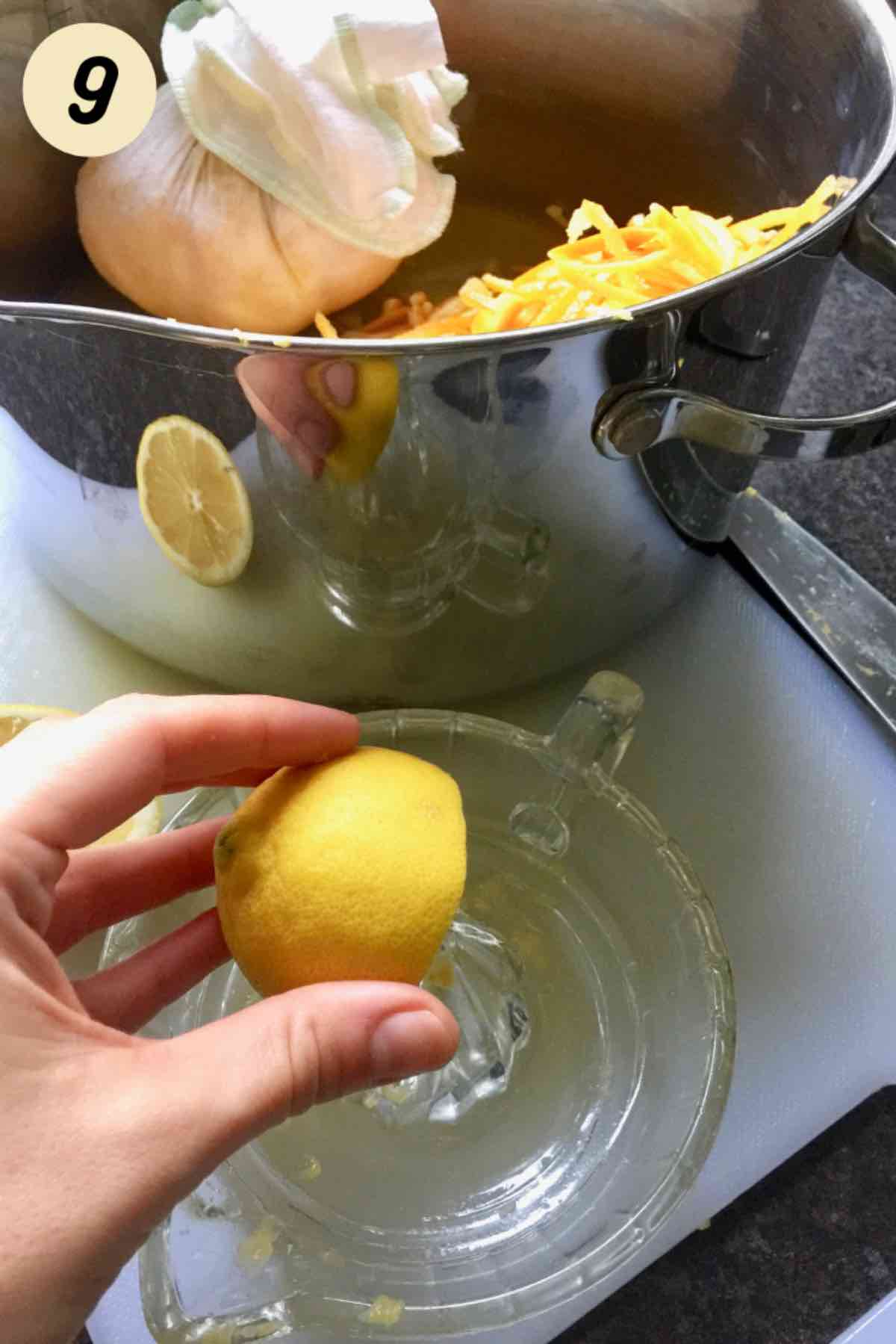
Pour 2.5 l water into the pan and place it over medium heat and bring to boil.
Lower the heat and simmer for approximately 2 hours until orange peel is nice and soft. You can check it by giving it a gentle squeeze between your fingers.
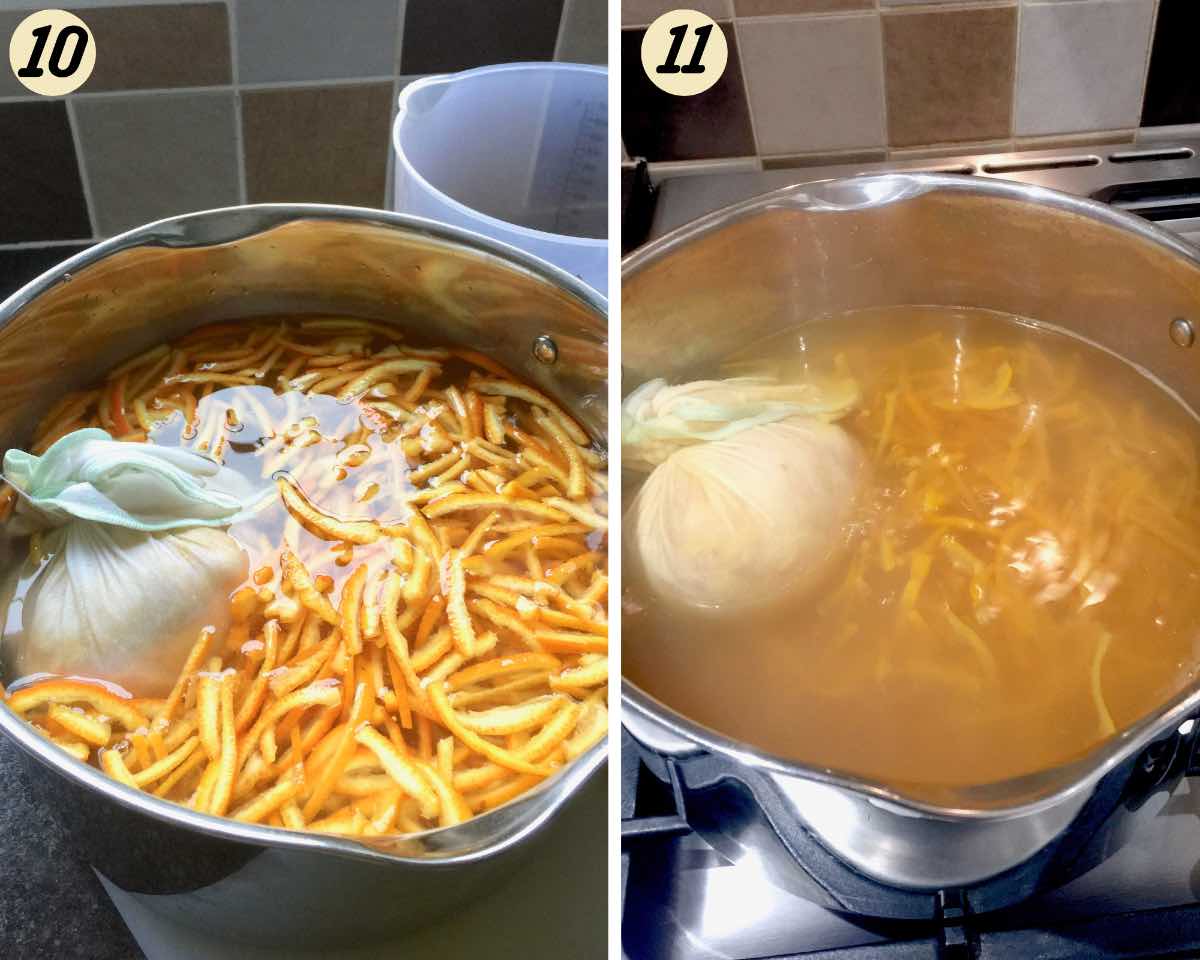
Remove pan from the heat.
Take muslin bag out of the pan trying to squeeze out as much of the pectin goodness as possible by pressing it against the side of your pan with the spoon. Alternatively, squeeze the bag with your hands (wear silicone gloves as it’ll be super hot or simply wait for it to cool down).
Add sugar to the pan and put it on low heat until it dissolves stirring from time to time. Make sure you let the sugar dissolve completely before you crank up the heat and bring marmalade to boil.
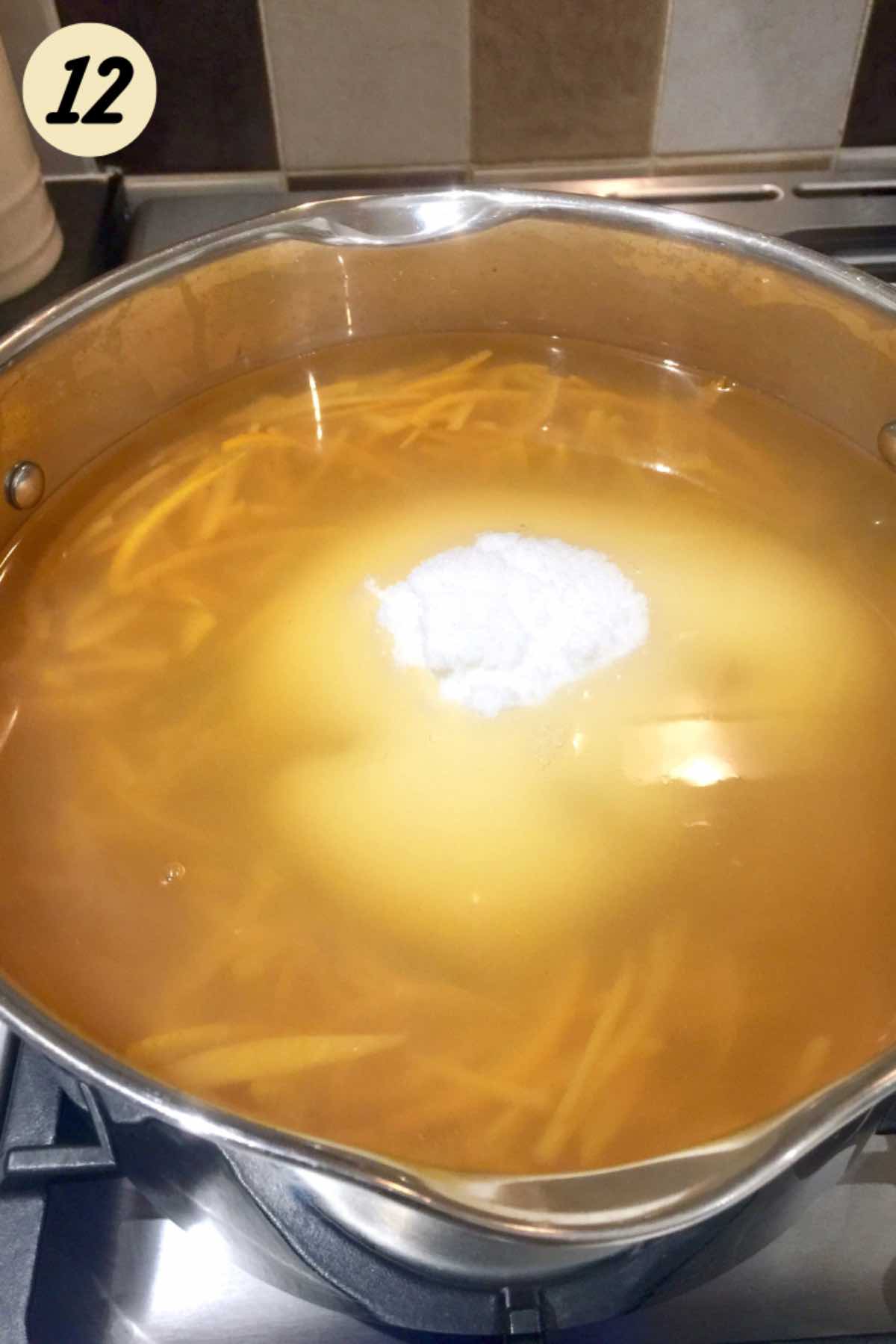
Once sugar has dissolved, increase the heat and bring the mixture to boil (it may take some time).
Quick Tip: At this point try and disturb the mixture as little as possible to prevent sugar from crystallising once cool.
Once you get to the point of nice rolling boil with lots of foamy scum (impurities) on top, let it boil for 15 minutes.
Quick Tip: There will be much less impurities if you use preserving sugar instead of granulated or caster.
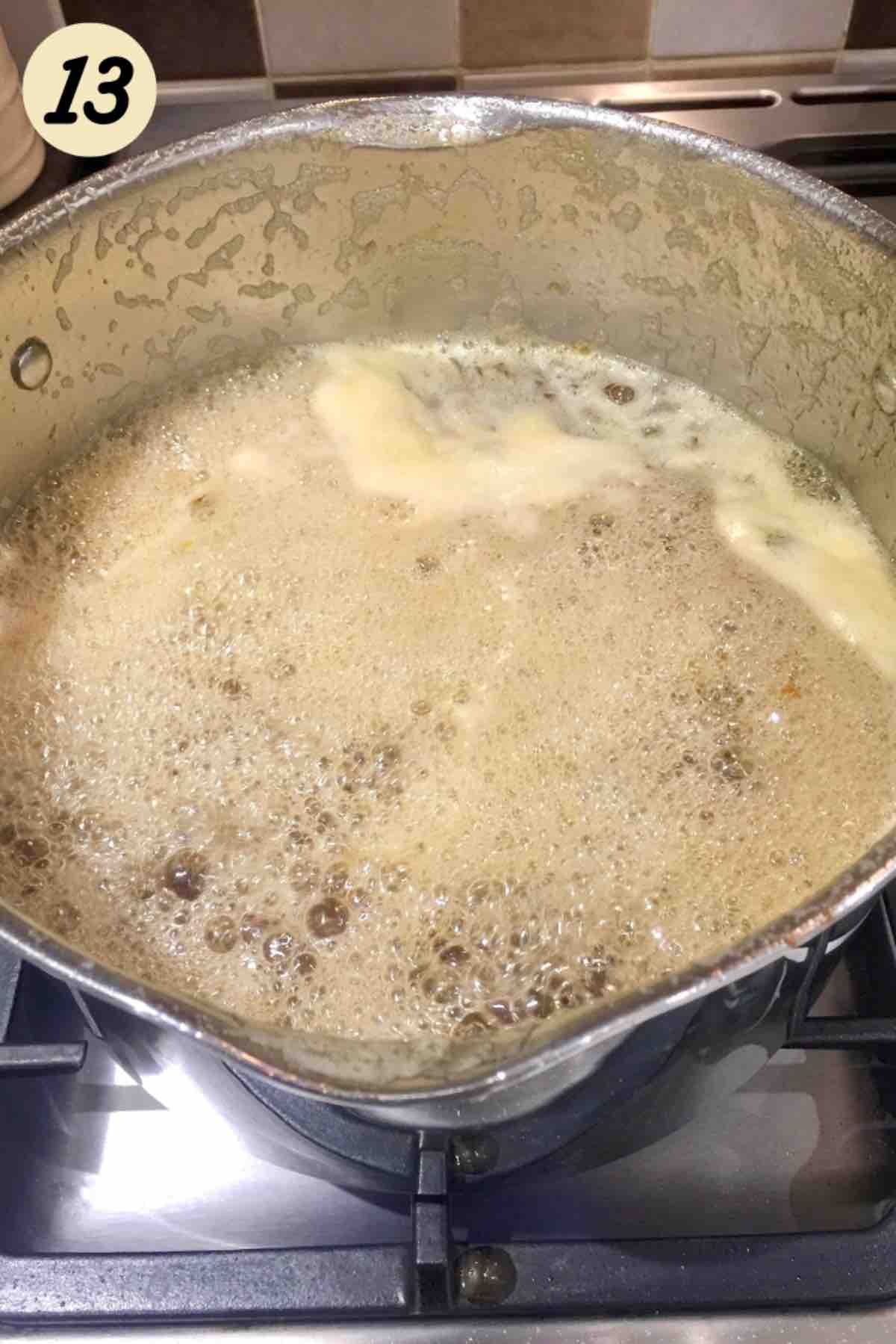
Take a saucer out of the freezer and spoon a little bit of marmalade onto it to check whether it’s set. To do that, simply push the liquid with your finger and if it wrinkles your marmalade is done. If it hasn’t reached setting point simply continue boiling it for another 5-10 minutes and do the wrinkle test again. You might have to repeat it few times so don’t get discouraged.
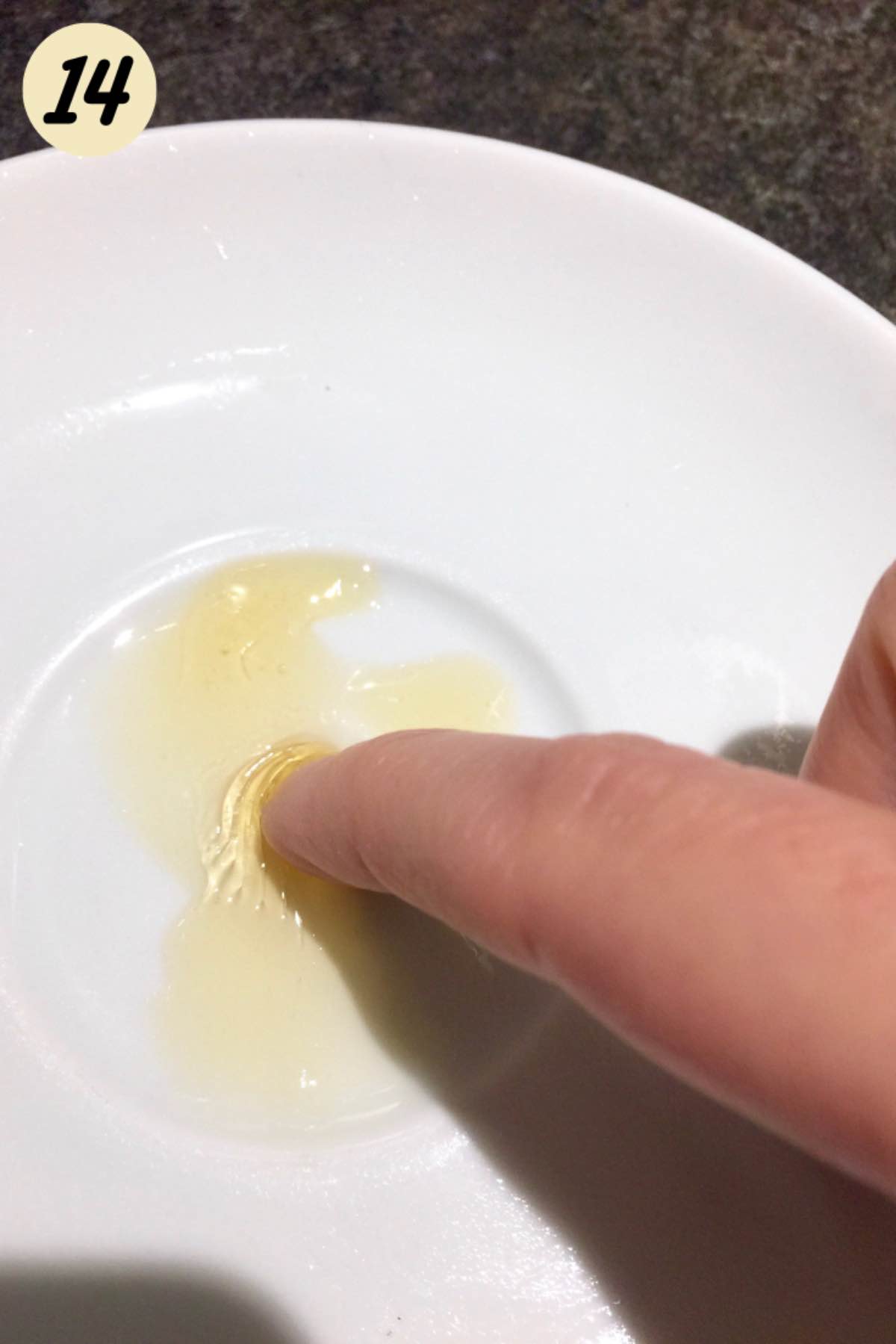
Once marmalade has reached setting point, turn off the heat and let it sit for 10-15 minutes. Skim the excess scum with a spoon.
Now is also the time to add any extras (alcohol of your choice, ginger etc.).
Quick Tip: Allowing marmalade to sit before potting allows it to settle a bit which should help keeping the peel evenly distributed once in jars.
Transfer orange marmalade to sterilised jars, cover with lids and leave to cool.
Marmalade will continue to set as it cools down. Once your jars are completely cold you can label them and store in dark and relatively cool place or enjoy immediately!
🍽 Equipment
Large pan or preserving pan - I must say I do not own a preserving pan and have used my old trusty stock pot for making my marmalade. Make sure the pot you use is nice and big (at least 5l).
Sieve - A must to strain the juice into the pan and for keeping the pips.
Muslin cloth/cheese cloth - When making our orange marmalade we are relying on pectin provided by all the pips & piths from the fruit which we will be discarding later. Putting them into a little parcel made out of a muslin square, will make disposal super easy later.
Citrus juicer - I'm using my old school citrus juicer but if beside marmalade making you're enjoying freshly squeezed orange juice it might be worth investing into something that will make your life easier like this electric juicer.
Sharp knife - I like using my super sharp chef's knife but some people prefer smaller pairing knives for slicing orange rind. Choose whatever suits you!
Jam Thermometer - Simple and easy to use, will definitely help to check whether marmalade is close to or has reached setting point.
Quick Tip: Even though I own and use jam thermometer, I still like to do "wrinkle test" (cold plate test) to double check.
Small saucers/plates for "wrinkle test" (see Pro Tips below).
Measuring jug - It will come handy when pouring hot marmalade into the jars.
Wooden Spoon - Perfect for stirring and fishing out the muslin bag.
Jam jars - You can use any clean old jam jars you've got to hand. I used a selection of old jam/honey jars I had at home which I washed and sterilised. For the quantity of marmalade from this recipe you will need approximately 9 (340g) jam jars.
🥡 Storing
Store jars with marmalade in a dark and cool place, away from excessive light and heat.
Marmalade should last up to 2 years (or even longer) if stored properly.
Once opened, store in the fridge for up to 3 months.
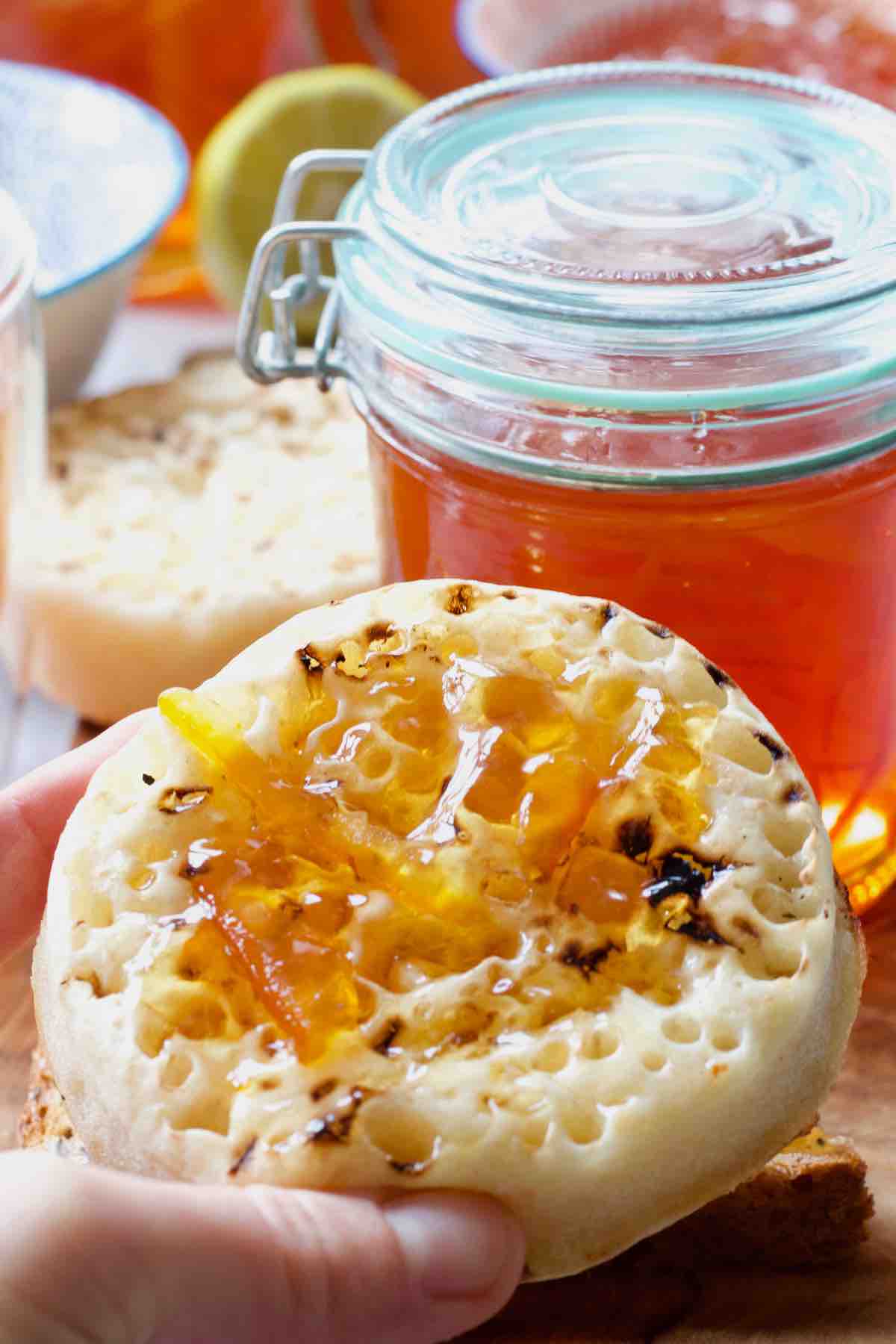
💭 Pro tips
Reserve some time. Marmalade making is more of a marathon rather than a sprint so choose the day when you know you don't have to rush or be finished by certain time as timing here can be a bit unpredictable.
Enjoy the process. Making your own marmalade may seem a bit daunting but it really is quite easy. Allow some time (see ⬆️) and enjoy!
Use organic fruit if possible. As we are using the entire fruit here I would highly recommend paying that bit extra for organic fruit that hasn't been sprayed with pesticides. However, if non-organic is all you've got make sure you give it a good scrub.
Orange peel. Cut it as thinly or as thickly as you like. Mine is cut sort of in between the two which is how I like it.
Muslin bag with pips & pith is full of pectin that releases as you boil the peel for 2 hours. However, when you take the bag out of the pan, make sure you squeeze as much of the pectin goodness as possible. Be careful as the bag will be super hot so use gloves is possible (silicone oven gloves are great for this). You can also wait until it cools down and give it a good squeeze then.
Marmalade setting point is 105C/221F so if you've got jam thermometer definitely use it to check whether your orange marmalade has reached it. I would still do the "wrinkle test" though just to double check.
"Wrinkle test" is done using well chilled saucer/plate on which you spoon a dollop of marmalade after it's been on rolling boil for 15 minutes. Once on the plate, you push marmalade with your finger and if it "wrinkles" it is ready. If it appears runny, continue boiling it for another 5-10 minutes and check again.
Take the pan off the heat when checking for set. You don't want to risk overcooking your marmalade which will make it go dark in colour and really thick once cool.
Sterilise your jars. If you want to preserve your marmalade for some time without it going mouldy, your jars need to be sterilised.
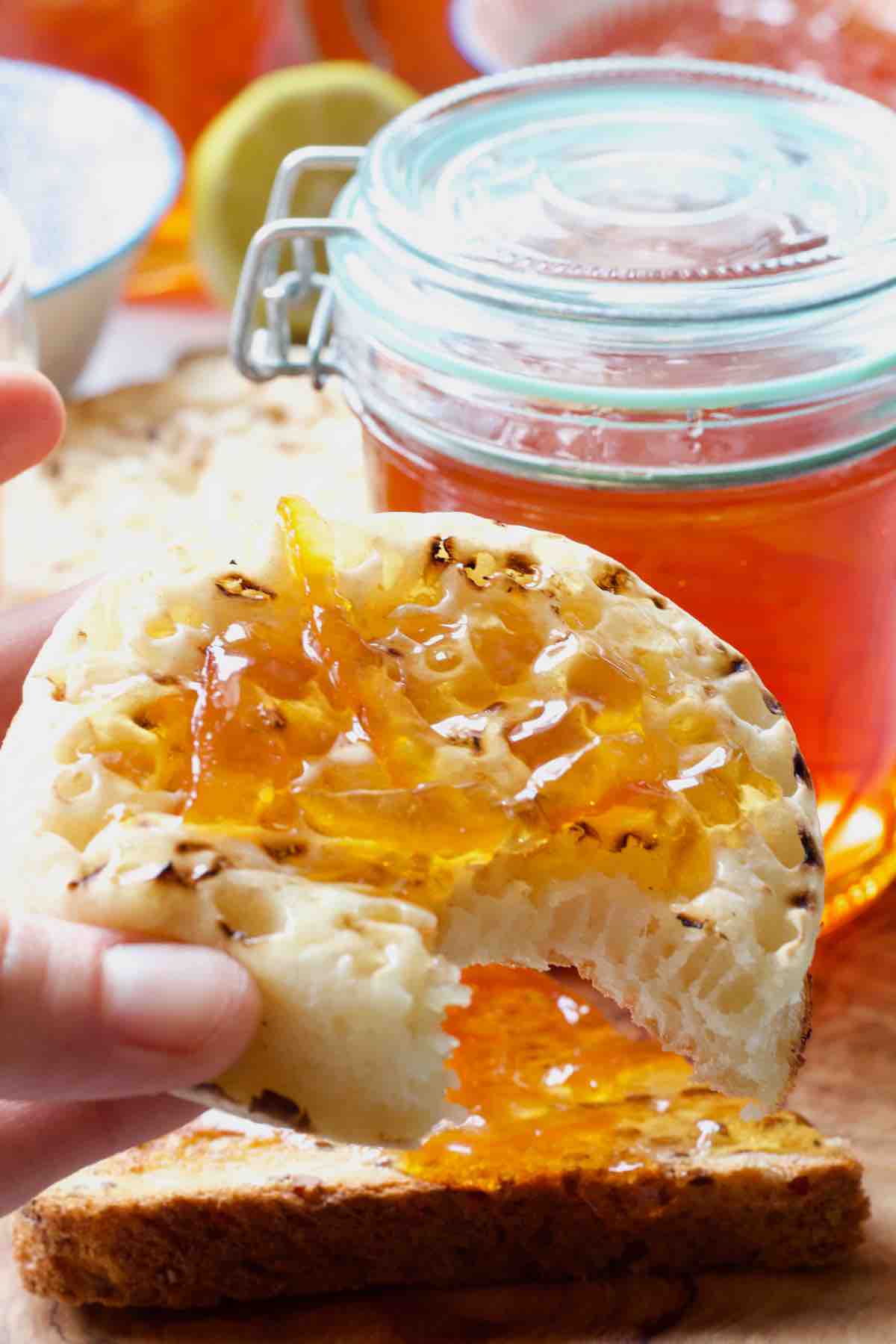
📖 Variations
Once you get to grips with making basic marmalade you can explore different flavour variations.
If adding your favourite tipple like whiskey, brandy or some fresh grated ginger for a bit of spice sounds appealing then you should experiment.
Quick Tip: Add your extras once marmalade has reached setting point.
🍴 Serving suggestions
Homemade marmalade makes most delicious and simple breakfast.
Try it on a thick slice of my Irish Soda Bread, toasted Easy Wholemeal Bread (no-knead) or (if you prefer white bread) Easy White Sandwich Bread (soft-crust).
If you are more of a bread roll fan, my Easy Bread Rolls or Yogurt Bread Rolls will be perfect here.
And don't forget crumpets!
You can also use this gorgeous marmalade to make a glaze for the Orange Glazed Tofu Roast.
It can also be used for muffins and cakes galore. So many delicious uses.
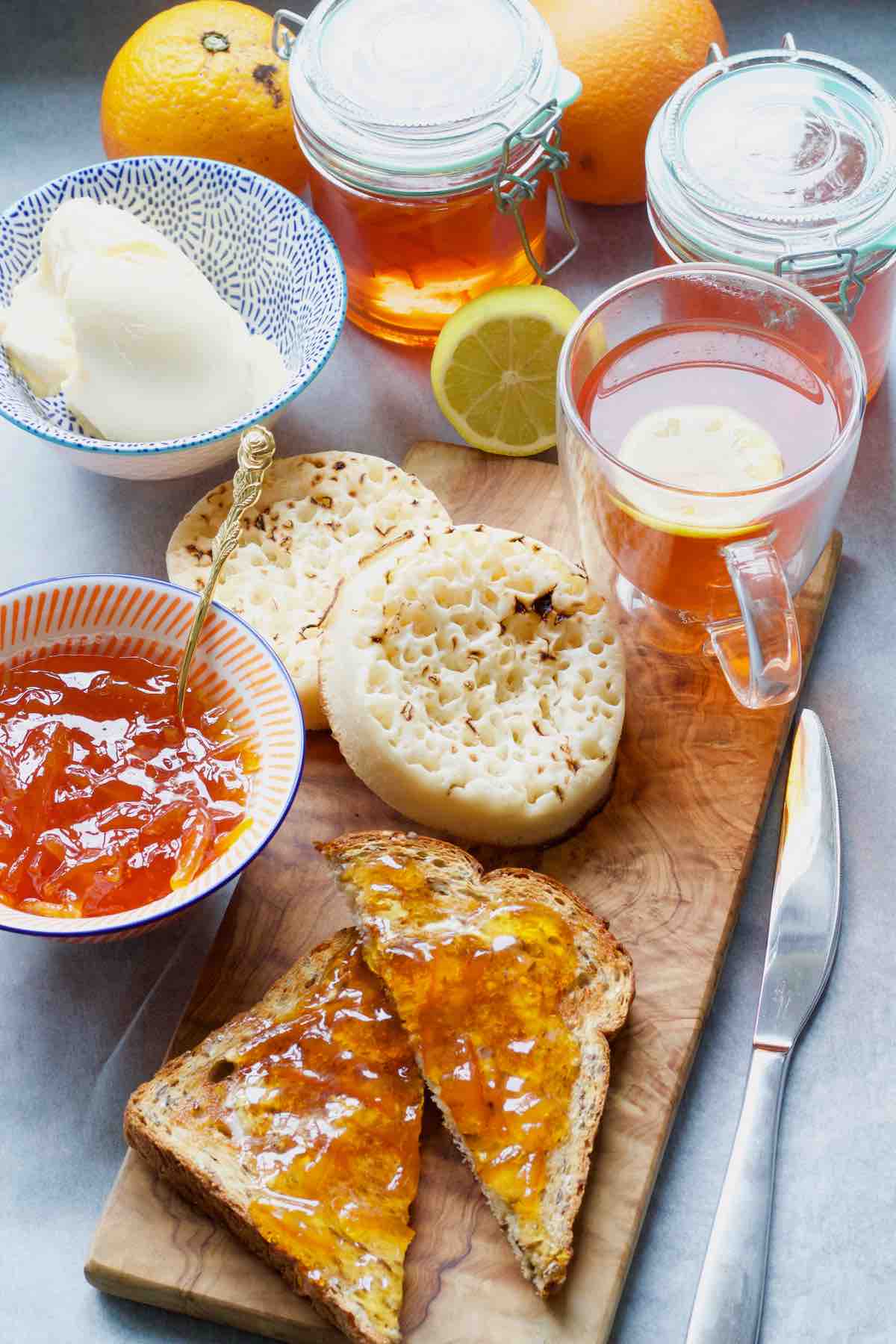
❓ FAQs
Yes you can but you will not get the same bittersweet flavour as you do when using seville oranges. Sweet oranges are also lower on pectin so I would recommend adding more lemon juice to counteract that.
You can use granulated, caster or preserving sugar. Don't use jam sugar.
You check it by doing what I call "wrinkles test". It is done using well chilled saucer/plate on which you spoon a dollop of marmalade after it's been on rolling boil for 15 minutes. Once on the plate, you push marmalade with your finger and if it "wrinkles" it is ready. If it appears runny, continue boiling it for another 5-10 minutes and check again.
You can reboil it until you get the required set. Marmalade sets as it cools down so you might want to wait until it's cool before reboiling.
If you've already potted it, simply decant it back to the pan and reboil until you reach setting pot. You will need to wash and re-sterilise your jars if doing that.
To sterilise your jars simply wash them (together with lids) in hot soapy water and dry stood up on a clean baking tray in the oven preheated to 150°C/300F for 10-15 min. The jars should be straight from the oven when you pour in your hot orange marmalade. Alternatively, pop them on a hot dishwasher cycle but time it right so that they're ready when marmalade is.
Have you tried making my Seville Orange Marmalade?
Please consider giving it ⭐️⭐️⭐️⭐️⭐️ rating in recipe card below and share your views or tips in the comments.
😋 More recipes you might enjoy:
Easy Blackberry Jam (No Pectin)
📋 Recipe
How to Make Marmalade
Equipment
- small plates/saucers
- jam jars
Ingredients
- 1 kg Seville Oranges see notes
- 1 lemon
- 2 kg granulated, preserving or caster sugar unrefined golden caster or granulated can be used as well
- 2.5 l water
- Optional extras: whisky, brandy, grated ginger etc.
Instructions
- Put 3-4 small saucers/plates in the freezer for later. You will need them to check whether marmalade has reached the setting point later.
- Prepare the jars and make sure you’ve got the lids for all of them to avoid lots of faff later.
- Cut oranges in half and squeeze out all the juice pouring it into the pan through the sieve to catch the pips. Remember to keep the pips!1 kg Seville Oranges
- Cut the orange peels into quarters and using a teaspoon (find one with relatively sharp edge) scrape out as much of the white pith from the skins as possible. Put it aside with saved orange pips.
- Take a muslin square/cotton cloth/cheese cloth and put all the pips and pith on it, gathering into a parcel and tying it up with a string or a strong thread. Make the string/thread long enough to be able to tie the parcel to the handle of the pot for easier removal later. Put the bag into the pot and tie it onto the handle for easier removal later. Do not skip this step as this pip/pith bag contains a lot of pectin you will need for your marmalade to set.
- Cut orange peel into strips. I like to cut my quarters into halves and slice them really thinly using a sharp knife. Feel free to cut your peel as thin or as thick as you like, it really is personal preference.Once you’ve sliced all the peel pop it into the pan.
- Halve and juice one lemon adding the juice to the pan.1 lemon
- Pour 2.5 l water into the pan and place it over medium heat and bring to boil. Lower the heat and simmer for approximately 2 hours until orange peel is nice and soft. You can check it by giving it a gentle squeeze between your fingers.2.5 l water
- Remove pan from the heat. Take muslin bag out of the pan trying to squeeze out as much of the pectin goodness as possible by pressing it against the side of your pan with the spoon. Alternatively, squeeze the bag with your hands (wear silicone gloves as it’ll be super hot or simply wait for it to cool down). Add sugar to the pan and put it on low heat until it dissolves stirring from time to time. Make sure you let the sugar dissolve completely before you crank up the heat and bring marmalade to boil.2 kg granulated, preserving or caster sugar
- Once sugar has dissolved, increase the heat and bring the mixture to boil (it may take some time). Once you get to the point of nice rolling boil with lots of foamy scum on top, let it boil for 15 minutes.At this point try and disturb the mixture as little as possible to prevent sugar from crystallising once cool. Once you get to the point of nice rolling boil with lots of foamy scum (impurities) on top, let it boil for 15 minutes.There will be much less impurities if you use preserving sugar instead of granulated or caster.
- Take your saucer out of the freezer and spoon a little bit of marmalade onto it to check whether it’s set. Simply push the liquid with your finger and if it wrinkles your marmalade is done. If it hasn’t reached setting point simply continue boiling it for another 5-10 minutes and do the wrinkle test again. You might have to repeat it few times so don’t get discouraged.
- Once marmalade has reached setting point, turn off the heat and let it sit for 10-15 minutes. This will allow it to settle which will help keeping the peel evenly distributed once in the jars. Skim the excess scum with a spoon.Now is also the time to add any extras (alcohol of your choice, ginger etc.).
- Transfer orange marmalade to sterilised jars, cover with lids and leave to cool. Marmalade will continue to set as it cools down. Once your jars are completely cold you can put labels on store in dark and relatively cool place or enjoy immediately!
Notes
- Nutritional information is approximate, per tablespoon of marmalade and should be treated as a rough guideline only.
- You can buy Seville Oranges in the UK from late December until mid February. They freeze well (whole) so even if you don't fancy making marmalade now, stock up for later.
- My orange marmalade recipe is naturally vegan and gluten-free.

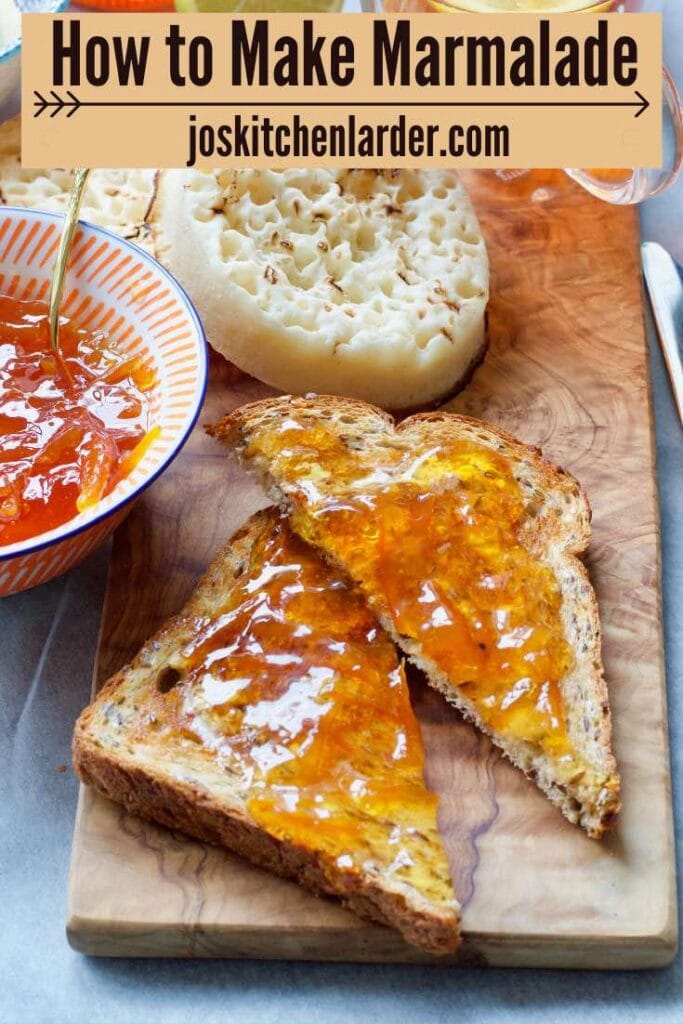
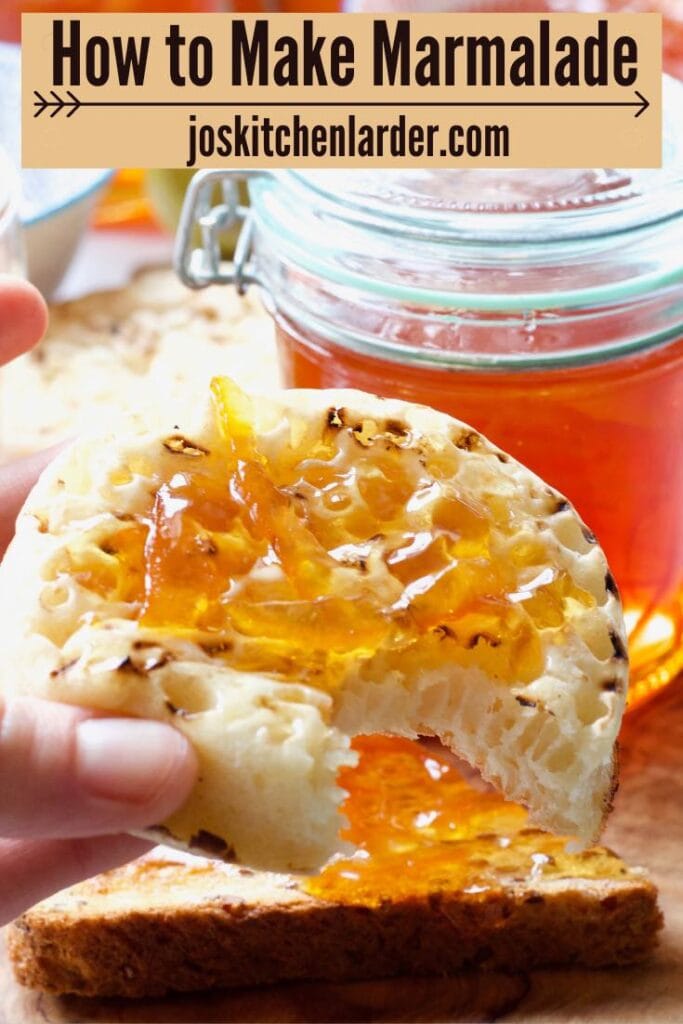
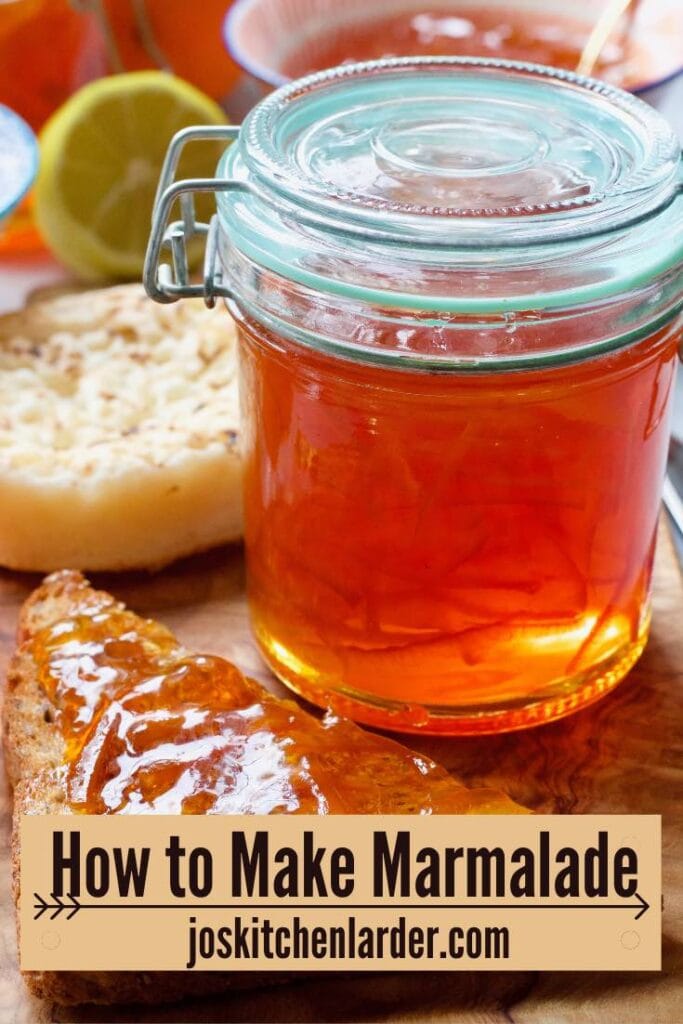
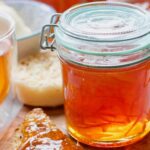

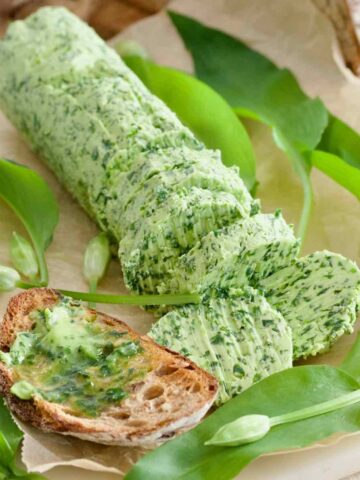
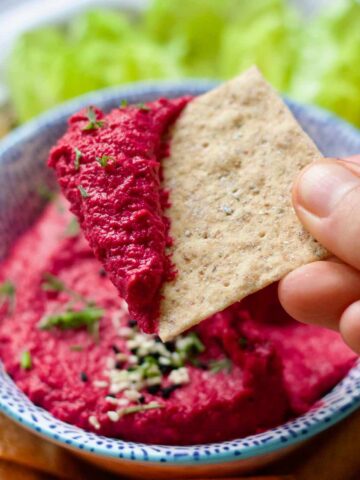
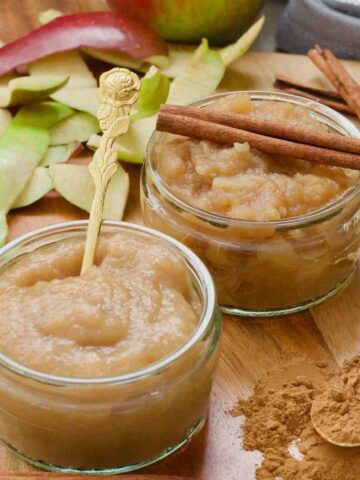
Patricia says
Hi there I was wondering how would you freeze Seville Oranges please?
Also, does caster sugar work as well as granulated?
Many thanks
joskitchenlarder says
Hi Patricia, You freeze oranges whole and unpeeled. I would also wash them prior to freezing. Once you're ready to make marmalade you can either defrost the fruit first and proceed with the recipe or you can cook them from frozen but that would change the way in which you make the recipe slightly. As for the sugar both caster and granulated work well. Hope that helps.
Harriett says
Am thinking of trying this with blood oranges and jam sugar Would it be ok. Also at what stage and quantity could I add ginger to normal recipe. Boyfriend loves ginger jam and it's not easy to get Ireland. Thanks
joskitchenlarder says
Hi Harriett, I think blood oranges should work pretty well here but I cannot comment on jam sugar as I've never used it before. Citrus fruit is naturally high in pectin so I wouldn't think there is a need for it and you might be risking it setting really solid. However, if you wanted to use jam sugar I would perhaps try making it without the bag with pith and pips as it's there purely for pectin. You might have to experiment. 🙂 As for the ginger, add some at the beginning of the process together with the juice and peel. I hope that helps a bit. 🙂
Harriett Wilson says
I made this with the blood oranges, I like marmalade a bit more solid so I used some jam sugar, ran out of caster sugar so made up the 2kg from a mix of granulated, caster, golden caster and jam sugar! It took a while for it to reach setting point, I included the pith, etc, but it worked and the marmalade is lovely and tangy. I am quite happy for a first try. Next time I will make a smaller batch with the ginger. Going to buy some more blood oranges and freeze them for future use.
joskitchenlarder says
Really pleased blood oranges worked nicely for you. 🙂
Eb Gargano | Easy Peasy Foodie says
Love seville marmalade - my mum used to make it every year when I was growing up. The smell in the kitchen was heavenly and I especially loved helping her 'test' to see it the marmalade was properly set. Obviously this did not just involve the wrinkle test, but also a thorough taste test! Eb x
joskitchenlarder says
I must say I never knew the flavour of seville orange marmalade until I was a proper adult and it wasn't love from the first sight either lol. I'm a living proof that our taste buds change as we get older as it is now by far my favourite preserve. 🙂 x
Lou | Crumbs and Corkscrews says
Wow, the colour is beautiful! I'm not a big Marmalade person, but my husband loves it! He's also a fan of jam and preserves making so I'm going to share this with him as I'm sure he'd love to try this out. Thank you for sharing #CookBlogShare
joskitchenlarder says
Thanks Lou! 🙂 Please do and let me know if he decides giving it a go.
Rosemary says
I too am the only marmalade-lover in my household. I've never made my own before but am definitely inspired to give it a go this year!
Jacqui – Recipes Made Easy:Only Crumbs Remain says
I love homemade marmalade it's just the best. This year I've made mine in the pressure cooker which is a big time saver.
joskitchenlarder says
So agree Jacqui! I'm so intrigued by your marmalade in pressure cooker, were the results as you expected?
Helen @ family-friends-food.com says
I love marmalade but have never made my own (although I've made jam lots of times). You make it look so easy! I'll have to give it a try. Thanks for sharing this with #cookblogshare 🙂
joskitchenlarder says
Thank you Helen! 🙂 I used to fear marmalade making despite loving marmalade itself but if I can make it anyone can!
Donna says
Orange marmalade on toast is one of my favorite treats. I could eat it every day. Great recipe!
joskitchenlarder says
Thanks Donna! 🙂 Absolutely, so simple and so delicious!
Monika Dabrowski says
I am a huge fan of marmalade, especially the homemade kind, and your instructions and illustrations are great. Really helpful and clear. Pinned.
joskitchenlarder says
Thank you so much Monika! 🙂
Danielle Wolter says
I am dying to try this! I don't have seville oranges, but I have access to hundreds and hundreds of fresh tangerines. I'll definitely try this with those. Sounds incredible!
joskitchenlarder says
Thanks Danielle! 🙂 Definitely give it a go! You will need more lemon juice though for that extra pectin as tangerines aren't as pectin rich as Seville Oranges.
Bintu | Recipes From A Pantry says
We go through a lot of marmalade in my house so I could definitely do with making my own! It looks delicious and the step by step guide is very helpful!
joskitchenlarder says
Thanks Bintu! 🙂 I hope you give it a go!
Demeter says
Love the flavor from homemade so much more! Thank you for all the helpful tips.
joskitchenlarder says
Thank you Demeter! 🙂 Definitely! You cannot beat homemade preserves, they are so worth the effort.
Lisa | Garlic & Zest says
I have a Calamansi Lime tree in my backyard, which is kind of like a cross between an orange and a lime -- wonder if I could make this with them... Looks so good.
joskitchenlarder says
Thank you Lisa! 🙂 Oh wow, never heard of Calamansi Lime, will need to look it up!
Julia says
Your process shots are really helpful! And thanks for the tips, I had no idea you can freeze whole oranges and use them later.
joskitchenlarder says
Thank you Julia! 🙂 I'm pleased you found them helpful, hopefully they will convince those who consider marmalade making as too difficult to give it a go! I know you wouldn't have thought so but they freeze beautifully.